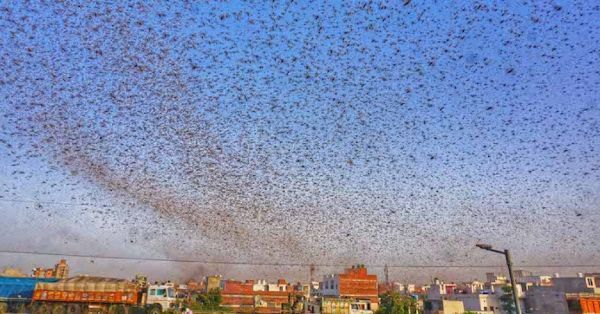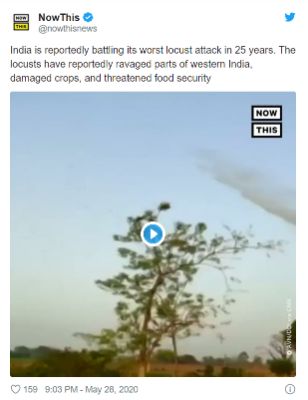Warnings Of 'Catastrophic Consequences' As Locust Swarms Hit India & Pakistan Amid COVID-19 Crisis
by Common Dreams - Andrea GermanosFor India, the invasion comes alongside "eviscerating heat."
by Andrea Germanos, staff writer

Farmers in India and Pakistan fear potentially catastrophic crop damage as another wave of locust swarms wreaks havoc on the two nations as they continue to battle coronavirus pandemic.
Locusts, as CBS News reported, are "considered the most destructive migratory pest in the world, with a small swarm of about 40 million locusts capable of gobbling up enough food for 35,000 people."
For India, the current invasion marks the "worst plague in nearly three decades," Agence France-Presse reported.
"Usually they arrive from Pakistan between July and October and remain focused in Rajasthan," added CBS. "This time, however, weather conditions have helped the swarms spread into neighboring states."
The grasshopper-like creatures "have engulfed around 35,000 hectares in India's seven heartland states, threatening some vegetable and pulse crops," Reuters reported Tuesday, citing information from government officials and farm experts.
The swarms began entering the country last month through neighboring Pakistan's Sindh province, and farmers fear another June wave of locusts could decimate crops.

The Associated Press reported that India is facing three disasters at once—locusts, Covid-19, and "eviscerating heat." From the AP:
Temperatures soared to 118 degrees Fahrenheit (47.6 degrees Celsius) in the capital New Delhi this week, marking the warmest May day in 18 years, and 122 F (50 C) in the desert state of Rajasthan, after the world’s hottest April on record.
India suffers from severe water shortages and tens of millions lack running water and air conditioning, leaving many to seek relief under shady trees in public parks and stepwells, the ancient structures used to harvest rainwater.
Though many people continued wearing masks properly, others pushed them onto chins, or had foregone them altogether.
K.L. Gurjar, deputy director of India's Locust Warning Organization, said Pakistan may have been overwhelmed by the huge number of locusts.
Pakistan's farmers have borne the brunt of the damage from the swarms.
Mir Gul Muhammad, who farms in the province of Balochistan, told the Guardian that the invasions have been the worst he's seen in this lifetime. "As a farmer, it will take years to recover from this loss," he said.
From the Guardian:
Ismail Rahoo, state minister of agriculture for Sindh, described the plague as a "dangerous and catastrophic threat to the economy, agriculture, and food security in Pakistan."
"This year it will be ten times worse than last year. They are attacking from three sides," he said. "The locusts and their eggs have now covered 50,000 square kilometres of farmland. We are expecting them to infest more than 5m hectares. And they are not just attacking Sindh province, but also the agricultural areas of Punjab and Balochistan."
The Food and Agriculture Organization (FAO) warned back in January that the swarms then hitting the Horn of Africa represented "an unprecedented threat to food security and livelihoods." The agency issued another warning in April as a second wave was spotted that the numbers could surge.
In a statement last week on the locusts affecting the Sahel, Southwest Asia, the Horn of Africa, and Yemen, the FAO expressed concern about the likelihood of new swarms forming in June, saying that "the battle is long and is spreading to new areas."
"The locusts, combined with the impacts of Covid-19, could have catastrophic consequences on livelihoods and food security," said FAO Director-Genera Qu Dongyu.